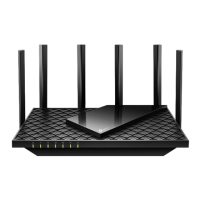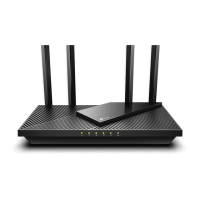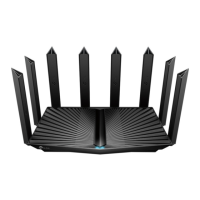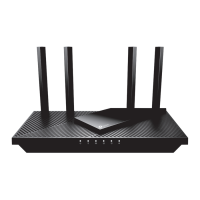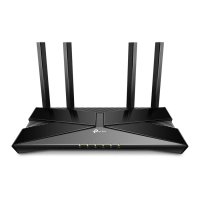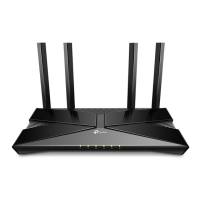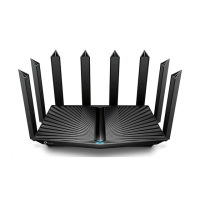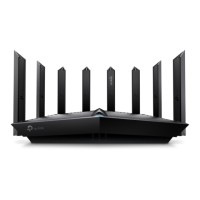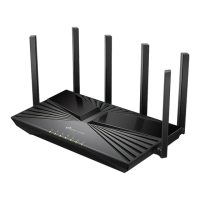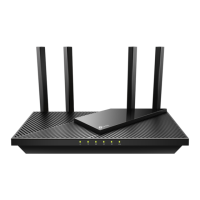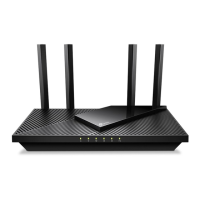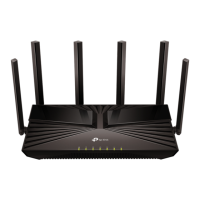Do you have a question about the TP-Link Archer AX73 and is the answer not in the manual?
Overview of TP-Link AX router with Wi-Fi 6 Technology, OFDMA, 1024QAM.
Details the physical appearance of the router, including panels and LEDs.
Describes the LEDs on the top panel and their indications.
Explains the components and ports located on the back panel of the router.
Details the components and ports located on the side panel of the router.
Guidelines for optimal placement of the router for performance and safety.
Step-by-step instructions for connecting the router to your modem and devices.
Guides users through the automated setup process for internet connection.
Provides steps for manual internet connection setup based on ISP type.
Instructions for configuring the router to function as an access point.
Steps for configuring an internet connection using IPv6 protocols.
Guide on creating and registering a TP-Link ID for cloud services.
How to add or remove TP-Link IDs for router management.
Using the TP-Link Tether app to manage the router remotely.
Customizing wireless network name (SSID), password, and security options.
Using Wi-Fi Protected Setup (WPS) for easy wireless device connection.
Configuration of advanced wireless parameters like WMM, Airtime Fairness, etc.
Steps to set up a separate Wi-Fi network for guests.
Configuring a captive portal for guest network authentication.
Connecting and accessing files on USB storage devices locally or remotely.
Sharing media files from USB storage via DLNA for playback on supported devices.
Tools for protecting the network from malicious attacks and intruders.
Setting restrictions on internet access for family members.
Creating a unified Wi-Fi network with mesh extenders for seamless coverage.
Viewing and managing devices within the OneMesh network.
Utilizing the SPI Firewall to protect against cyber threats.
Blocking or allowing specific devices to access the network via MAC address.
Binding IP addresses to MAC addresses to prevent ARP spoofing.
Configuring port forwarding to share local network services over the internet.
Setting up a DMZ host to expose a device to the internet with all ports open.
Setting up an OpenVPN server for secure remote access to the home network.
Configuring a PPTP VPN server for remote access to the home network.
Setting up an L2TP/IPSec VPN server for secure remote access.
Configuring the router to act as a VPN client to access remote servers.
Modifying the router's LAN IP address and subnet mask.
Configuring DHCP server settings, including IP address pool and reservations.
Configuring DDNS to access the router using a domain name.
Instructions for updating the router's firmware via auto, online, or local methods.
Backing up and restoring router configuration settings.
Changing the password for accessing the router's web management page.
Controlling access to the router's management interface from the local network.
Configuring remote access for managing the router over the internet.
Saving and sending system logs for troubleshooting network issues.
Steps to recover or reset the wireless password if forgotten.
Procedures for recovering or resetting the router's login password.
Troubleshooting steps for internet connectivity issues after setup.
Resolving problems with finding or connecting to wireless networks.
Overview of TP-Link AX router with Wi-Fi 6 Technology, OFDMA, 1024QAM.
Details the physical appearance of the router, including panels and LEDs.
Describes the LEDs on the top panel and their indications.
Explains the components and ports located on the back panel of the router.
Details the components and ports located on the side panel of the router.
Guidelines for optimal placement of the router for performance and safety.
Step-by-step instructions for connecting the router to your modem and devices.
Guides users through the automated setup process for internet connection.
Provides steps for manual internet connection setup based on ISP type.
Instructions for configuring the router to function as an access point.
Steps for configuring an internet connection using IPv6 protocols.
Guide on creating and registering a TP-Link ID for cloud services.
How to add or remove TP-Link IDs for router management.
Using the TP-Link Tether app to manage the router remotely.
Customizing wireless network name (SSID), password, and security options.
Using Wi-Fi Protected Setup (WPS) for easy wireless device connection.
Configuration of advanced wireless parameters like WMM, Airtime Fairness, etc.
Steps to set up a separate Wi-Fi network for guests.
Configuring a captive portal for guest network authentication.
Connecting and accessing files on USB storage devices locally or remotely.
Sharing media files from USB storage via DLNA for playback on supported devices.
Tools for protecting the network from malicious attacks and intruders.
Setting restrictions on internet access for family members.
Creating a unified Wi-Fi network with mesh extenders for seamless coverage.
Viewing and managing devices within the OneMesh network.
Utilizing the SPI Firewall to protect against cyber threats.
Blocking or allowing specific devices to access the network via MAC address.
Binding IP addresses to MAC addresses to prevent ARP spoofing.
Configuring port forwarding to share local network services over the internet.
Setting up a DMZ host to expose a device to the internet with all ports open.
Setting up an OpenVPN server for secure remote access to the home network.
Configuring a PPTP VPN server for remote access to the home network.
Setting up an L2TP/IPSec VPN server for secure remote access.
Configuring the router to act as a VPN client to access remote servers.
Modifying the router's LAN IP address and subnet mask.
Configuring DHCP server settings, including IP address pool and reservations.
Configuring DDNS to access the router using a domain name.
Instructions for updating the router's firmware via auto, online, or local methods.
Backing up and restoring router configuration settings.
Changing the password for accessing the router's web management page.
Controlling access to the router's management interface from the local network.
Configuring remote access for managing the router over the internet.
Saving and sending system logs for troubleshooting network issues.
Steps to recover or reset the wireless password if forgotten.
Procedures for recovering or resetting the router's login password.
Troubleshooting steps for internet connectivity issues after setup.
Resolving problems with finding or connecting to wireless networks.
| Modulation | 1024-QAM, OFDM |
|---|---|
| Wi-Fi band | Dual-band (2.4 GHz / 5 GHz) |
| Wi-Fi standards | 802.11a, 802.11b, 802.11g, Wi-Fi 4 (802.11n), Wi-Fi 5 (802.11ac), Wi-Fi 6 (802.11ax) |
| Top Wi-Fi standard | Wi-Fi 6 (802.11ax) |
| WLAN data transfer rate (max) | 5400 Mbit/s |
| WLAN data transfer rate (first band) | 4804 Mbit/s |
| WLAN data transfer rate (second band) | 574 Mbit/s |
| MU-MIMO technology | Yes |
| Memory card slot(s) | - |
| Ethernet LAN (RJ-45) ports | 4 |
| USB 3.2 Gen 1 (3.1 Gen 1) Type-A ports quantity | 1 |
| Cabling technology | 10/100/1000Base-T(X) |
| Networking standards | IEEE 802.11a, IEEE 802.11ac, IEEE 802.11ax, IEEE 802.11b, IEEE 802.11g |
| Ethernet LAN data rates | 10, 100, 1000 Mbit/s |
| Ethernet LAN interface type | Gigabit Ethernet |
| Antennas quantity | 6 |
| Processor cores | 3 |
| Processor frequency | 1500 MHz |
| SIM card slot | No |
| WAN connection type | RJ-45 |
| Product type | Portable router |
| Product color | Black |
| Output current | 2.5 A |
| Output voltage | 12 V |
| Power source type | DC |
| Security algorithms | WPA, WPA-Enterprise, WPA2, WPA2-Enterprise, WPA3 |
| Supported network protocols | IPv4, IPv6 |
| Cables included | LAN (RJ-45) |
| Storage temperature (T-T) | -40 - 70 °C |
| Operating temperature (T-T) | 0 - 40 °C |
| Storage relative humidity (H-H) | 5 - 90 % |
| Operating relative humidity (H-H) | 10 - 90 % |
| Harmonized System (HS) code | 85176990 |
| Sustainability certificates | RoHS, Federal Communications Commission (FCC), CE |
| Package depth | 265 mm |
| Package width | 415 mm |
| Package height | 90 mm |
| Package weight | 1490 g |
| Depth | 147.2 mm |
|---|---|
| Width | 272.5 mm |
| Height | 49.2 mm |
